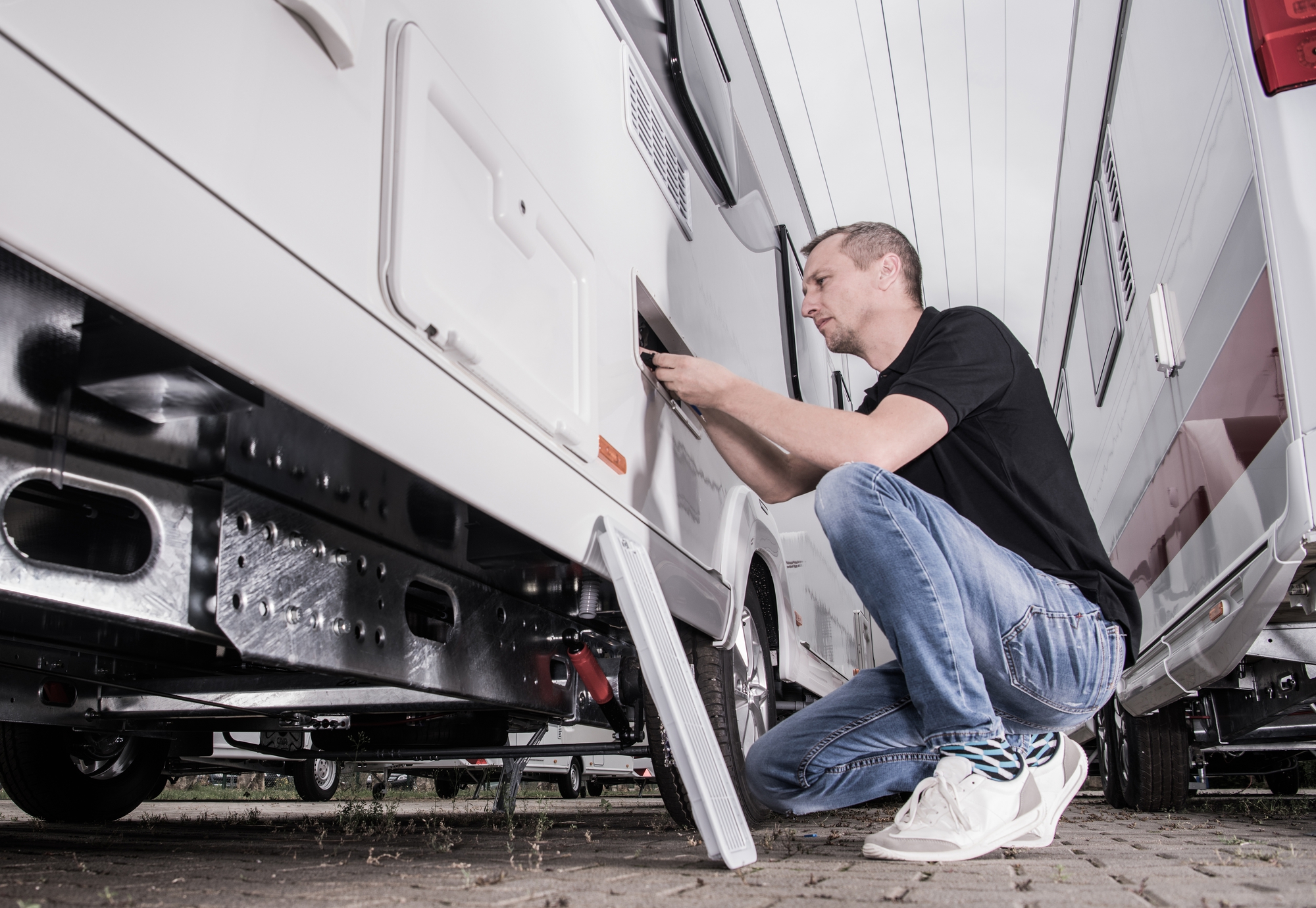 The worst thing about your RV, or any vehicle, suddenly breaking down or a part of it not working as it should is the entire process of getting your warranty provider to do something about it and the time you’ll have to spend to address it. When you’re faced with a malfunction in your RV, navigating the warranty service process might seem daunting, but it doesn’t have to be. Be prepared and learn about the basic steps of dealing with RV warranty claims. Doing so can significantly streamline the claims process. Stay tuned to uncover effective strategies for handling the process and understanding what your warranty covers to ensure your RV is back on the road with minimal hassle.
The worst thing about your RV, or any vehicle, suddenly breaking down or a part of it not working as it should is the entire process of getting your warranty provider to do something about it and the time you’ll have to spend to address it. When you’re faced with a malfunction in your RV, navigating the warranty service process might seem daunting, but it doesn’t have to be. Be prepared and learn about the basic steps of dealing with RV warranty claims. Doing so can significantly streamline the claims process. Stay tuned to uncover effective strategies for handling the process and understanding what your warranty covers to ensure your RV is back on the road with minimal hassle.
Difference Between an RV Extended Warranty and Insurance
Understanding the difference between an RV’s extended warranty and insurance is crucial for any RV owner, as they serve distinct, vital roles. Insurance companies and their coverage protect you from unforeseen events like accidents or theft, covering costs that arise from damage or loss. It’s your safety net on the road, ensuring you’re not financially stranded.
On the other hand, an extended RV warranty is more about peace of mind over your vehicle’s mechanics and systems. This warranty policy kicks in to cover the costs of repairs for specific parts of your RV that might break down due to wear and tear. It’s not about if the unexpected happens, but when the usual wear does. Your RV will come with a manufacturer warranty when you purchase it, thanks to consumer protection laws. Still, its coverage can be limited, which is where an extended RV warranty comes in.
Don’t hesitate to get an extended RV warranty because it’s not just about avoiding paying for any mechanical issue; it’s about ensuring your trip is salvageable and you get the support you, your family, or your friends need on any trip.
Steps to Making an RV Warranty Claim After an Issue Arises
Extended warranty companies can sometimes make you go through several hoops just to get a minor repair. Yet, most of them follow a basic process that you should memorize and anticipate. We also have prepared some tips to better navigate the warranty claim process, which you can read later on. Let’s start with the first step after suddenly finding yourself with an RV mechanical problem.
Take a Deep Breath and Determine the Problem
Take a deep breath, and try to pinpoint exactly what’s wrong with your RV. Whether it’s a mechanical hiccup or something more serious, identifying the issue is your first step towards freedom on the road again. Start by checking the most common trouble spots. Is it an engine problem, electrical failure, or perhaps a plumbing issue? Making a list of symptoms can help clarify the situation for both you and the warranty providers. Once you’ve nailed down the potential problems, you’re in a better position to navigate your claim efficiently through any warranty department. Remember, most repairs under warranty will require a clear explanation of the issue. This understanding can streamline the process, getting you back to your adventures with minimal downtime.
Check Your Policy and See If Your Problem is Covered
Next, review your RV warranty policy to determine if your specific issue is covered. It’s crucial to understand the details of your warranty contract. Check every clause related to coverage. Is your current headache—a busted fridge, a leaky roof—listed? Understanding these details ensures that you’re not caught off guard. Remember, warranties vary; some cover more ground than others. Don’t assume; verify. If it turns out that your problem isn’t a warranty item, you’ll save yourself a fruitless claim process. This step isn’t just bureaucracy; it’s about knowing your rights and navigating them smartly.
Call the Warranty Provider, Make the Claim, and Find Nearest Repair Facility
After confirming your issue is covered, call your warranty provider to initiate the claim and ask for the nearest licensed repair facility or service center. The number should be on your contract or warranty card. In some cases, you might also consider mobile RV mechanics, especially if traditional repair shops have long wait times or if your warranty plan accepts mobile repairs.
Also, find the contract number for which you’ll need to make the claim. Don’t let paperwork tie you down—getting this step right means you’re closer to hitting the road again. You’ll find that interacting directly with warranty companies can clarify any mysteries about your RV warranty. They’ll guide you to a repair shop that knows your RV inside out, ensuring you’re not just any customer in a queue once you get there. This approach not only speeds up the process but also places you in capable hands quickly.

Repair Facility Needs to Make a Diagnosis
Once the repair facility receives your RV, they’ll need to diagnose the problem to proceed with the warranty claim. This crucial step confirms if the issue falls under your warranty coverage. It’s the key to ensuring your vehicle is back on the road without unnecessary delays or costs. The technicians will meticulously inspect your recreational vehicle to pinpoint the exact nature of the malfunction and the overall repair costs. This process is vital; it separates warranty issues from normal wear and tear or unrelated damages. Trust in their expertise, but stay informed—understanding the diagnosis helps you navigate the complexities of warranty claims more effectively.
Get Pre-Authorization for Repairs
With the diagnosis confirmed, you’ll need to get pre-authorization from your warranty provider before any repair attempts can begin. This step is crucial, especially if you’re dealing with extended warranties or specific warranty periods that dictate terms and conditions. Contact your provider directly—don’t wait! Explain the situation and provide the necessary details as pinpointed by the repair facility. Make sure to ask about any specific forms or documentation required. Dealers often have direct lines of communication with warranty companies, which can expedite the process. Getting pre-approval ensures that the financial aspects are covered, letting you focus on the adventures ahead.
Repairs Start
Now that you’ve received pre-authorization, the repair shop can begin working on your RV. This stage is crucial, as it puts you back on the road to freedom. Remember, detailed documentation is your best friend here. Keep all records and receipts; they’re your proof of the repair process and are often required by insurance companies. Make sure the repair shop understands your coverage plan to ensure that all actions are within the terms of your warranty. It’s your right as an owner to stay informed, so don’t hesitate to ask for updates or details about the repairs. Being proactive and involved helps streamline the process, ensuring that you’ll be exploring again in no time.
Warranty Then Pays Repairs, and You’re Good to Go
After the repair shop completes the work, your warranty provider will handle the payment, and you’re ready to hit the road again. This is where your freedom truly kicks back in. No need for lawyers or stressful negotiations. As the customer, you’re back in the driver’s seat—literally. The warranty steps in like a reliable party, ensuring that financial hiccups don’t stall your adventure. Remember, this seamless process is designed to keep you moving, not hold you back. Always ensure you’ve communicated clearly and documented everything, just in case. Now, with your RV in top shape and the bills taken care of, you can focus on what’s ahead. Enjoy the journey, free and unencumbered.

Tips for a Hassle-Free Warranty Claim Process
As we mentioned, navigating the RV warranty claim process can be smooth if you’re armed with the right information from the start. We’ve covered the basic steps, but here is some extra advice that can avoid surprises or preventable issues when your next breakdown occurs.
Make Sure Initial Estimate Includes All Key Information
Ensure your initial estimate from the repair facility comprehensively details all necessary repairs and cost of repairs to facilitate a smooth warranty claim process. Check that your estimate clearly outlines the scope of work, including labor hours and parts needed. It’s your roadmap to getting things sorted fast. Don’t forget to verify that all services and parts listed are covered under your warranty terms; this avoids unexpected costs that could tie you down.
Include VIN and Mileage Always in Claims
Always include your RV’s VIN number and current mileage in your warranty claims to streamline the process. These details are crucial for a hassle-free experience, as they help identify your vehicle and track its history. Without this information, you might face delays or even denials in your claim because the warranty provider can’t verify your RV’s eligibility or past service records accurately.
Consider Getting RV Roadside Assistance and Trip Interruption Coverage
When you’re out exploring the open road, the last thing you want is to be sidelined by unexpected mechanical issues. Roadside assistance can be your safety net, offering help like towing, tire changes, or emergency fuel service. Many extended warranties also offer lodging, transportation, and even a rental car in case the repairs take longer than a day or are too severe for you to continue your trip and you need a ride back home. It ensures that help is just a call away, so you won’t be stuck for long. You’re all about freedom, right? Don’t let a breakdown keep you from your adventures. With roadside assistance included in your warranty, you’ll have peace of mind knowing that whatever happens, you’re covered and can quickly get back to enjoying your journey. It’s about traveling with confidence.
Always Have a Copy of Your Warranty Contract on Hand
Keep a copy of your warranty contract on hand to streamline the claims process when you need it. This simple action gives you the freedom to tackle issues head-on, wherever your travels take you. Instead of scrambling to find your contract in an email somewhere or having to call someone when you’re miles from home, you’ll have all the necessary details right at your fingertips. This ensures you’re not only prepared but also in a stronger position to negotiate or clarify what’s covered under your warranty. It’s your safety net, enabling you to address RV repairs quickly and get back on the road with minimal fuss. So, make sure you’ve got that contract handy—it’s your ticket to maintaining peace of mind on your open-road adventures.
Get an Extended RV Warranty with Southeast Financial for Better Coverage
Navigating RV warranty claims doesn’t have to be a headache. Once you understand the basics of the process and stay proactive and informed, you’ll streamline the process. To ensure comprehensive and reliable coverage as well as services you can trust, opt for an extended RV warranty from Southeast Financial. This isn’t just about peace of mind; it’s about keeping your adventures on track without the hassle of unexpected repairs and costs.
Southeast Financial’s extended warranty could cover more than your standard warranty, ensuring minor issues don’t turn into major roadblocks. You’ll appreciate the freedom to explore without the worry of mechanical failures, knowing you’re backed by a robust plan that handles unexpected problems swiftly and efficiently. Drive confidently, knowing you’re well-prepared to handle any bumps on the road!

